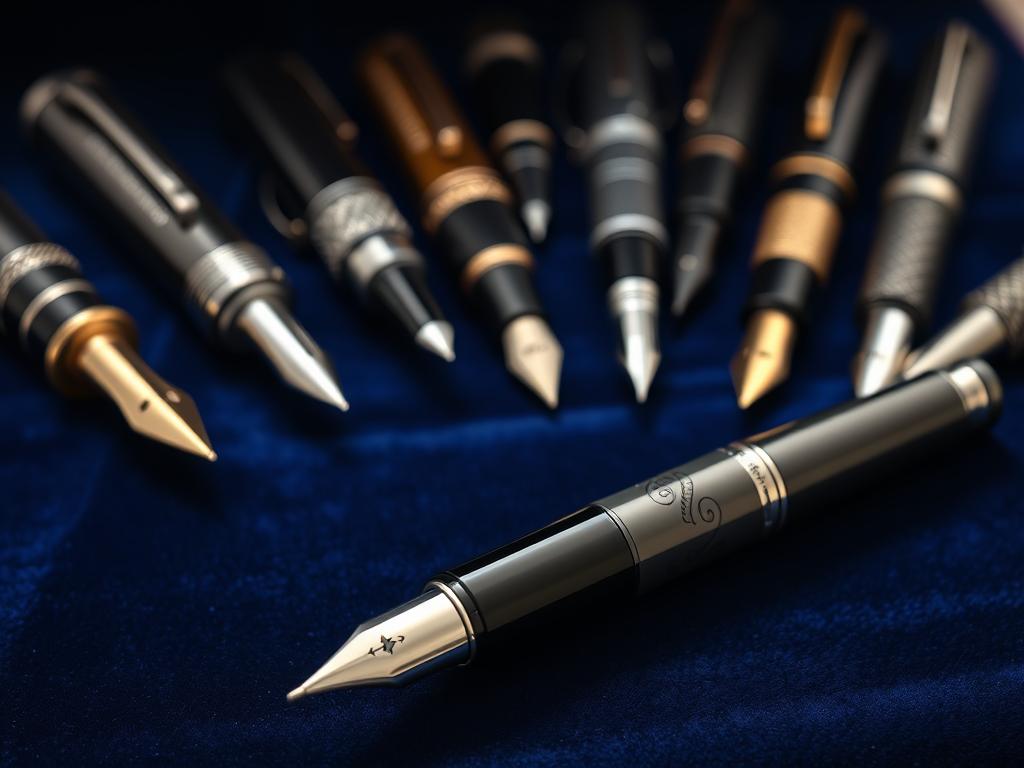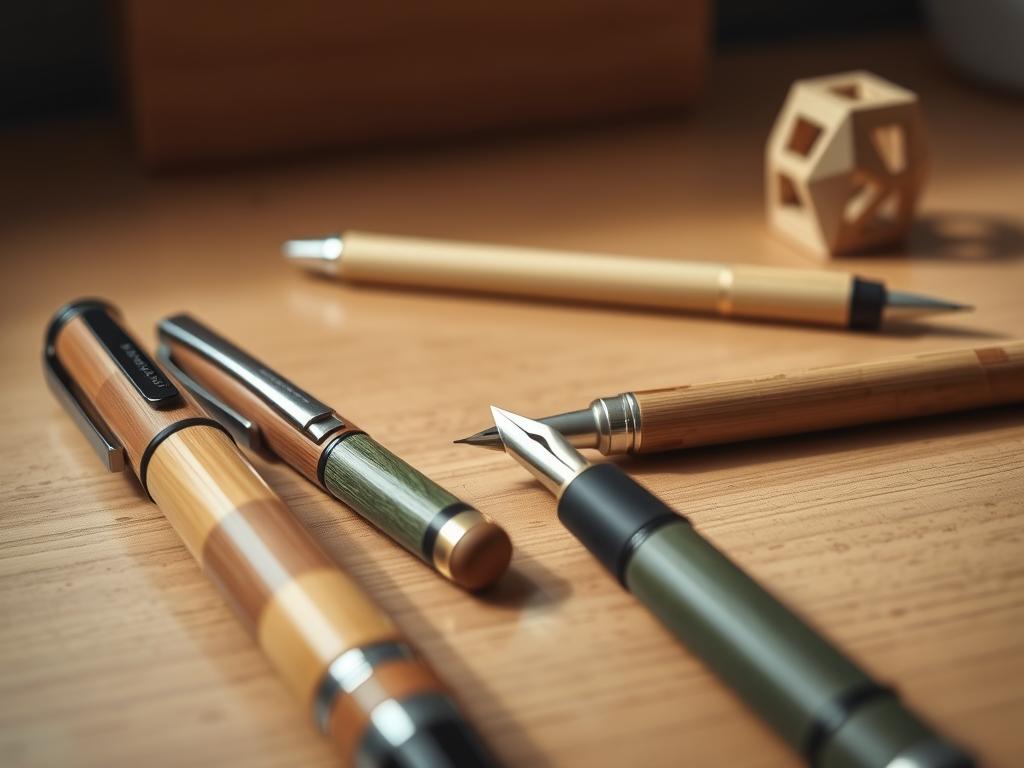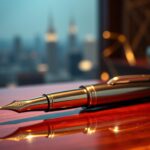Certain writing tools transcend their basic purpose, blending artistry with history to become timeless treasures. These items are more than just instruments—they are crafted narratives of human ingenuity, often reflecting decades of innovation. For instance, Waterman’s groundbreaking ink feed system in the 1880s revolutionized how people wrote, while brands like Montegrappa continue to merge Italian elegance with precision engineering.
What makes these pieces stand out? Their designs often feature rare materials, from hand-polished resins to precious metals. They also carry stories: Parker’s iconic models accompanied historic signings, and Montblanc’s limited editions celebrate cultural milestones. Such details transform them into functional heirlooms, appealing to those who value legacy as much as aesthetics.
Today’s market celebrates both tradition and innovation. Artisans experiment with sustainable practices, like recycled gold or ethically sourced celluloid, without compromising on quality. This balance ensures each piece remains relevant in modern collections while honoring its heritage.
Key Takeaways
- High-end writing tools often double as historical artifacts with unique design stories.
- Brands like Waterman and Montegrappa set standards through technical and artistic breakthroughs.
- Materials such as gold, resin, and enamel elevate these items beyond everyday use.
- Many models have played roles in significant cultural or political events.
- Sustainability is becoming a key focus in contemporary craftsmanship.
- Understanding a pen’s background helps collectors appreciate its value.
The Legacy and History of Luxury Pens
The journey of writing instruments from practical tools to cultural symbols began with bold inventors. Jean-Benoit Mallat’s 1843 Siphoide design introduced early fountain mechanisms, though leaks remained common. Lewis Waterman changed this in 1884 by patenting a three-channel ink feed—finally solving messy spills.
Historical Milestones in Pen Development
Early 20th-century models like the Parker Lucky Curve used gravity to draw ink backward, preventing smudges. Conklin’s Crescent Filler (1897) featured a crescent-shaped lever for easier refills. These innovations laid the groundwork for modern reliability.
| Model | Year | Innovation |
|---|---|---|
| Siphoide | 1843 | Early fountain mechanism |
| Waterman Feed | 1884 | Leak-resistant design |
| Crescent Filler | 1897 | First self-filling system |
Influential Figures and Their Iconic Writing Instruments
Italian judge Giovanni Falcone documented mafia trials with a Montblanc Meisterstück. French philosopher Roland Barthes drafted essays using a Sheaffer Balance. Their choices highlight how tools shape legacies.
| Figure | Profession | Preferred Instrument |
|---|---|---|
| Giovanni Falcone | Magistrate | Montblanc Meisterstück |
| Roland Barthes | Philosopher | Sheaffer Balance |
Today’s limited edition releases often echo these classics. Brands blend vintage inspiration with modern materials, ensuring each piece tells a story worth preserving.
Innovative Designs and Modern Technology in Luxury Writing Instruments
Today’s masterpieces blend centuries-old craftsmanship with breakthroughs that redefine writing precision. Designers now use aerospace-grade alloys and 3D modeling to create instruments that feel timeless yet cutting-edge.
Advanced Ink Feed and Nib Engineering
Modern ink systems solve age-old frustrations. Brands like Pilot employ vacuum-sealed reservoirs to prevent leaks during flights, while Visconti’s “Power Filler” mechanism refills in seconds. Nibs crafted from iridium-tipped gold adjust to writing pressure, offering line variation rivaling brush strokes.
Artisans now laser-test each nib for smoothness. Aurora’s “Flex” models mimic vintage flex pens but use durable titanium. These innovations ensure consistent flow, whether drafting contracts or sketching landscapes.
Ergonomic and Technological Enhancements
Weight distribution matters as much as aesthetics. Lamy’s Dialog series features retractable nibs with counterbalanced bodies, reducing hand fatigue. Graf von Faber-Castell adds magnetic caps that snap shut silently—ideal for boardrooms.
Eco-conscious materials shine too. Caran d’Ache mixes recycled aluminum with walnut wood, proving sustainability complements elegance. Meanwhile, Montblanc’s “Augmented Paper” system digitizes handwritten notes, merging analog charm with digital convenience.
The Allure of Collectible Luxury Pens
What transforms a functional item into a sought-after artifact? For enthusiasts, it’s the marriage of history and craftsmanship that breathes life into every curve and detail. Take Montblanc’s Patron of Art series—each edition honors cultural icons like Ludwig van Beethoven, blending Baroque motifs with rhodium-plated accents.
Premium materials elevate these instruments beyond utility. Celluloid, first used in 1920s designs, creates vibrant swirls that mimic precious stones. Brands like Pelikan hand-polish this material for 30 hours to achieve depth. Gold nibs, often 18k or higher, adapt to writing styles over time. As one artisan notes:
“A well-crafted nib doesn’t just write—it learns.”
Limited runs amplify exclusivity. Visconti’s Homo Sapiens models use lava rock from Mount Etna, while Waterman’s 100th Anniversary piece features a diamond-set clip. These editions often sell out within hours, becoming instant heirlooms.
| Brand | Material Innovation | Notable Model |
|---|---|---|
| Montblanc | Precious resin (patented 1924) | Meisterstück Solitaire |
| Pelikan | Striped celluloid | Souverän M1000 |
| Visconti | Titanium alloy nib | Divina Desert Springs |
True appreciation lies in the details—the weight of a cap, the whisper of ink on paper. Whether it’s a vintage Parker Duofold or a modern Graf von Faber-Castell, each creation carries a narrative waiting to be held.
Limited Edition Fountain Pens: Exclusive Collector’s Pieces
In the realm of fine writing instruments, rarity transforms ordinary objects into cultural icons. These creations bridge artistry with storytelling, offering enthusiasts tangible connections to pivotal moments. Take the Parker Jack Knife Safety Pen—a 1920s marvel designed to prevent leaks during air travel. Its spring-loaded cap became a hallmark of innovation, favored by Ernest Hemingway during transatlantic journeys.

Rare Historical Models and Their Stories
Montegrappa’s 2011 Chaos edition reimagined mythology with sterling silver dragons coiled around the barrel. Only 1,911 pieces exist, commemorating the brand’s centennial. Similarly, Waterman’s 1915 Red Ripple combined hard rubber with gold accents, surviving World War I trenches in officers’ pockets. Such pieces aren’t just tools—they’re time capsules.
| Model | Year | Significance |
|---|---|---|
| Parker Jack Knife | 1926 | First leak-proof design for pilots |
| Montegrappa Chaos | 2011 | Mythological motifs in sterling silver |
| Waterman Red Ripple | 1915 | WWI-era durability with art deco flair |
Special Releases and Limited Prints
Modern releases push boundaries with unconventional materials. Visconti’s Homo Sapiens line uses volcanic rock from Mount Etna, while Graf von Faber-Castell’s Guilloche series features laser-engraved patterns. Limited runs—like Pelikan’s annual “Maki-e” editions—sell out within hours, blending Japanese lacquer techniques with European engineering.
For collectors, these items symbolize personal style and global sophistication. As one enthusiast notes:
“Each piece carries whispers of its maker’s hands and the eras it witnessed.”
Whether displayed or used, they anchor acollection’s narrative, proving that scarcity fuels passion across theworld.
Exceptional Materials and Exquisite Craftsmanship
The soul of a writing instrument lies in its materials and the hands that shape them. Brands like Montegrappa transform raw elements into functional art, combining 18-carat gold nibs with celluloid that shimmers like gemstones. These choices aren’t just about looks—they ensure smooth ink flow and lasting durability.
Premium Metals, Celluloid, and Precious Inks
Gold remains the gold standard for nibs due to its flexibility and corrosion resistance. Artisans often spend weeks hand-polishing celluloid—a material prized for its depth and vintage appeal. Precious inks, like Pelikan’s Edelstein series, use pH-balanced formulas to prevent fading on the page.
Intricate Detailing and Artisanal Techniques
Master engravers carve patterns thinner than human hair using magnifying tools. One craftsman notes:
“Every curve must harmonize with the writer’s grip—it’s a dance between form and function.”
Proper maintenance, like monthly flushes with distilled water, preserves these details for generations.
Weight distribution plays a starring role too. A well-balanced design reduces fatigue during long writing sessions. For example, Aurora’s Optima model pairs a brass barrel with a lightweight cap, creating equilibrium that glides across the page. This meticulous attention elevates everyday use into an experience.
Versatility in Writing Instruments: Fountain, Rollerball, and Ballpoint Pens
Every writing task demands a unique touch, and the choice of instrument shapes that experience. Fountain, rollerball, and ballpoint options each bring distinct technology and aesthetics to the table, catering to diverse needs. Whether signing documents or journaling, these tools adapt to modern lifestyles while honoring traditional techniques.
Fountain pens use liquid ink and flexible nibs for expressive line variation. Their feeds require precise engineering to balance ink flow—a technique perfected over centuries. Rollerballs employ water-based ink for smoother gliding, ideal for quick notes. Ballpoints rely on oil-based ink that dries instantly, making them practical for everyday use.
| Type | Ink Technology | Best Use Case |
|---|---|---|
| Fountain | Liquid (flexible flow) | Calligraphy, signatures |
| Rollerball | Water-based (low pressure) | Long-form writing |
| Ballpoint | Oil-based (quick-dry) | Everyday tasks |
Collectors often rotate between styles. A lawyer might choose a fountain pen for contract signings but switch to a ballpoint during travel. One enthusiast notes:
“My Montblanc rollerball feels like writing on silk—perfect for heartfelt letters.”
Aesthetics also play a role. Sleek titanium ballpoints suit boardrooms, while hand-painted fountain pens shine at gallery openings. Brands like Pilot and Lamy now integrate ergonomic grips and sustainable materials, ensuring relevance in today’s fast-paced world.
These instruments prove that time-tested designs can coexist with modern demands. From vintage-inspired nibs to space-age alloys, they bridge tradition and innovation—one stroke at a time.
Montegrappa and the Art of Made in Italy Luxury Pens
Italian craftsmanship meets storytelling in Montegrappa’s creations, where every curve whispers centuries of tradition. Founded in 1912 near Venice, this brand transforms writing into an art form, blending Renaissance flair with modern innovation. Their workshop in Bassano del Grappa remains a hub for artisans who hand-polish resins and engrave precious metals.
Signature Collections and Iconic Designs
The Dragon series captures mythology with serpentine barrels wrapped in sterling silver. Each scale is etched by hand, requiring over 100 hours of labor. For the Muhammad Ali edition, designers fused boxing glove textures with gold accents, celebrating the champ’s legacy.
Collaborations drive their limited edition pens. Partnering with Ferrari, they crafted sleek models mimicking sports car aerodynamics. The Fortuna line uses Venetian glass inserts, reflecting Italy’s Murano heritage. These pieces aren’t just tools—they’re wearable history.
| Model | Year | Key Feature |
|---|---|---|
| Dragon | 2011 | Hand-etched sterling silver |
| Muhammad Ali | 2019 | 24k gold-plated details |
| Fortuna | 2022 | Murano glass inlay |
What defines a superior writing experience? Montegrappa’s nibs use iridium tips for smooth strokes, while ergonomic grips reduce fatigue. Unlike mass-produced ballpoint pens, their designs balance weight like a violinist’s bow—precise and effortless.
While French brands prioritize minimalism, and German makers focus on engineering, Montegrappa thrives on theatrical flair. As one collector notes:
“Their pens don’t just write words—they spark conversations.”
This philosophy keeps them at fashion weeks and museum exhibitions, redefining what a writing instrument can be.
Sustainable and Custom Luxury Pens: Modern Trends
Today’s writing tools blend environmental responsibility with personal flair, proving elegance doesn’t have to cost the Earth. Artisans now craft instruments using recycled aircraft aluminum and plant-based resins, while still delivering the precision expected from premium brands. This shift reflects a broader movement where ethical choices enhance both aesthetics and functionality.

Eco-Friendly Innovations and Ethical Materials
Brands like Caran d’Ache lead with pens made from 85% recycled steel, while Graf von Faber-Castell uses FSC-certified wood. Water-based inks and biodegradable packaging are becoming standard, aligning with sustainable luxury trends. Even nibs get a green makeover—Pilot’s “Justus” model features a recycled gold tip that adjusts to writing pressure.
Manufacturers also prioritize fair labor practices. Montblanc’s workshops now run on solar energy, and Aurora plants ten trees for every pen sold. These steps ensure every stroke leaves a lighter footprint.
Personalized Designs Reflecting Unique Style
Customization turns tools into extensions of personality. Montegrappa offers laser-engraved initials on barrels, while Visconti lets clients choose gemstone accents. One collector shared:
“My bespoke rollerball matches my wedding band—both carry stories.”
Limited edition pens now embrace individuality. Pelikan’s “Moonlight” series allows mix-and-match caps and barrels, creating over 200 combinations. For those seeking subtlety, Sailor’s “Hoshikuzu” model mimics starry skies with crushed pearl lacquer.
| Brand | Custom Feature | Material |
|---|---|---|
| Montegrappa | Laser engraving | Recycled titanium |
| Visconti | Gemstone inlays | Ethical gold |
| Pelikan | Modular designs | Bio-resin |
These innovations prove sustainability and self-expression can coexist. Whether choosing a sleek rollerball for the office or a vibrant fountain pen for journaling, modern instruments honor both personal taste and planetary health.
Conclusion
The evolution of writing instruments mirrors humanity’s quest for beauty and functionality. From early leak-prone designs to today’s precision-engineered nibs, these tools blend heritage with cutting-edge technology. Modern ink feed systems, born from decades of refinement, ensure smooth, uninterrupted flow—a game-changer for those who value the experience of putting thoughts to paper.
In the realm of new luxury, even the act of writing becomes a sensory journey. Advanced mechanisms merge form with function seamlessly. Artisans shape precious metals and sustainable alternatives with equal mastery, proving quality need not compromise ethics.
Limited runs and bespoke options let owners express individuality while owning a fragment of history. These instruments stand as testaments to human ingenuity, connecting users across generations. Whether drawn to vintage charm or contemporary innovation, there’s never been a better time to explore this world.
Each piece invites you to write your chapter in an ongoing story where art meets purpose. Discover how the right tool can elevate your experience, making every mark a celebration of legacy and progress. Here, tradition and tomorrow’s breakthroughs coexist—proof that true craftsmanship never goes out of style.
FAQ
Why do brands like Montegrappa hold such historical significance?
Montegrappa has crafted instruments since 1912, blending Italian artistry with storytelling. Their designs often honor cultural icons, from Hemingway to Venetian heritage, making them symbols of both craftsmanship and legacy.
How do modern writing tools balance ergonomic design with aesthetics?
Brands integrate advanced materials like titanium or resin with contoured grips and balanced weight distribution. This ensures comfort during extended use while maintaining elegant, eye-catching profiles.
What makes limited edition releases valuable to enthusiasts?
Limited runs often feature rare materials, hand-engraved details, or collaborations with artists. Their scarcity and unique narratives, like Montblanc’s tributes to historical figures, create lasting appeal.
Which materials are commonly used in high-end writing instruments?
Sterling silver, 18K gold nibs, celluloid, and lacquered finishes are popular. Brands like Visconti use materials such as lava rock or Damascus steel for distinct textures and durability.
How do fountain pens differ from rollerball or ballpoint options?
Fountain pens use liquid ink for smooth, expressive lines, while rollerballs employ gel-based ink for precision. Ballpoints use thicker ink, ideal for quick notes. Each offers a different feel and purpose.
Are sustainable practices influencing luxury pen production?
Yes. Brands like Graf von Faber-Castell use ethically sourced wood, while others recycle metals. Solar-powered facilities and biodegradable packaging are becoming standard in eco-conscious craftsmanship.
What maintenance ensures a fountain pen’s longevity?
Regular cleaning with lukewarm water prevents ink clogs. Storing horizontally keeps nibs moist, and using quality ink reduces sediment buildup. Annual servicing maintains optimal ink flow and nib alignment.
Can writing instruments be customized to reflect personal style?
Absolutely. Engraved initials, bespoke nib widths, or custom lacquer colors are options. Companies like Namiki even offer hand-painted motifs for a one-of-a-kind aesthetic.


